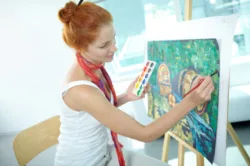Defining Art Therapy and the Benefits It Provides

The Power of Art in Therapy
When we think about counseling and therapy, traditional talk therapy often comes to mind. However, the creative arts world has increasingly demonstrated the significance of incorporating art into counseling sessions. Art therapy, as an adaptable modality, serves as a powerful tool that allows clients to communicate their needs and challenges non-verbally, offering a unique avenue for self-expression and healing.
Benefits of Group Art Therapy Through the Lens of a Board-Certified Art Therapist
Group art therapy enhances a sense of belonging by rising above verbal barriers and allowing clients access to storytelling and narrative work through artmaking. Art engages the motor and sensory components of the brain, aiding clients with cognitive blocks or overuse that can occur when verbally processing thoughts and experiences. Art also serves as a positive coping tool, facilitating emotional expression and accessing subconscious memories that are difficult to verbalize. Art therapy employs creative processes and artwork to promote therapeutic healing, benefiting clients of all ages, backgrounds, and diagnoses. The modality offers a non-threatening way to express and process emotions and is informed by a number of theoretical frameworks. This can translate to an increase in beneficial practices throughout treatment like improved connections, self-introspection, distress tolerance, mindfulness, coping skills, and overall life satisfaction.
Benefits of Therapeutic Artmaking Through the Lens of a Licensed Social Worker and Counselor
In traditional talk therapy, verbal expression is paramount. Yet, art as therapy provides non-certified clinicians with a window into clients’ inner worlds through non-verbal cues. A simple piece of paper and a pen can reveal volumes about a client’s emotions and experiences. From anxious scribbles to meticulous strokes, each artistic expression offers valuable insights into the client’s psyche. Art as therapy embraces inclusivity, meeting clients where they are in their healing journey. Whether using professional drawing materials or simple supplies like paper and found objects, art as therapy can invite clients to explore their inner landscapes through creativity. Through processes like collage, clients can weave together narratives and symbols to express their stories and emotions.
Trusting the Process: Self-Exploration through Creation
The essence of art therapy lies in trusting the creative process. Clients embark on a journey of self-discovery as they engage with imagery and creation. When utilizing art directives in session, clients are granted the ability to tap into self-expression and their inner child and are given a controlled space to help them contain their thoughts and feelings and explore and re-establish control.
Universal Language: Connecting on a Deeper Level
Art transcends language and culture, serving as a universal medium for human connection. Whether integrated into Role Play, Trauma-Informed work, or other therapeutic interventions, art therapy offers a profound means of communication and connection. Through symbolic expression, clients can give voice to their souls and navigate the depths of their inner worlds.
Embracing Art Therapy for Soulful Expression
In conclusion, art and creativity offer a rich tapestry of benefits for clients seeking healing and self-discovery. By harnessing the power of creativity, therapists can facilitate profound moments of insight and expression, guiding clients on a transformative journey of self-realization and growth. As we embrace art as a voice in therapy, we open doors to deeper understanding, connection, and healing for all.
*Cited:
Gussak, D.E., & Rosal, M. L. (2016). The Wiley Handbook of Art Therapy. John Wiley & Sons, Ltd.
Malchiodi, C.A. (2012). Handbook of Art Therapy (2nd ed.). The Guilford Press.








